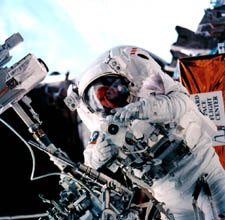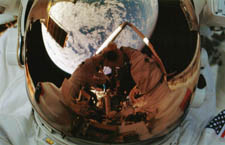The Nikon F5 Auto-Focus SLR : Photographing Space Walks
May 9, 2000

An EVA Photograph.
The Nikon F5 is protected with an
insulating "thermal blanket" fabricated
by NASA, with only the lens visible.
An auto-focus 35mm(135 format) single lens reflex camera from Nikon Corporation (President : YOSHIDA, Shoichiro) was carried into space by the NASA space shuttle "Discovery" in December 1999, as official extra vehicular activity (EVA) recording equipment.
The Nikon F5, equipped with an AF Nikkor lens, made the voyage into space and returned to earth safely.
The Nikon F5 and AF Nikkor lens used on the flight were subjected to the harsh environment of outer space, quite different from the environment in the pressurized cabin, but with the exception of a change in lubricants to a special compound requested by NASA*, were identical to those available commercially on the earth.
- *The lubricant had to be able to function normally in dry vacuum, across a wide temperature range from -50 to +110 C.

Nikon F5 + AF Nikkor 50mmF1.4D
Nikon's American subsidiary, Nikon Inc. (Head Office in Melville, New York ; President : FUKUCHI, Hideo) delivered a number of cameras and lenses using the specified lubricant to NASA :
Nikon F5 : 35 units
AF Nikkor 50mm f/1.4D : 12 units
AF Nikkor 35mm f/2D : 12 units
AF Nikkor 28mm f/2.8D : 8 units

A self-portrait by an astronaut on EVA. The helmet's visor (a solar shield protected with a vapor-deposited gold thinfilm)shows reflections of the earth, the space shuttle's remote control arm, and the Nikon F5 itself.
The primary mission of the Discovery was to repair and modify the Hubble Space Telescope (HST), in orbit around the earth.
A number of the functions of the HST have failed or deteriorated since its launch in April 1990, and this mission was designed to repair them, as well as replacing a number of systems including the onboard computer and measurement instrumentation.
The Nikon F5 and AF Nikkor lens were used during the 8-hour EVA. In principle, all photography was handled in the auto-focus mode, and thanks to trouble-free operation a host of invaluable photographs were taken.
Now that the Nikon F5 has successfully made the trip to space and back again, it joins the proud ranks of other "space cameras" in use on the space shuttle, including the Nikon F3 manual-focus 35mm SLR used for EVA photography, and the Nikon F4 auto-focus 35mm SLR used for photography inside.
- The information is current as of the date of publication. It is subject to change without notice.
